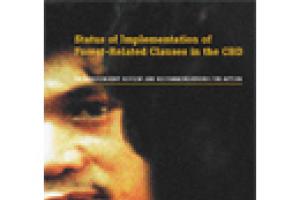Japan’s biggest paper manufacturer, Nippon Paper (NP) is known as an industry leader in environmental reform, but how real is this?
South East Fibre Exports at Eden, about 500 kms south of Sydney, is a NP subsidiary.
It is Australia’s oldest chipmill and was the first overseas operation of the former Daishowa Paper Manufacturing Company (taken over by NP a couple of years ago).
Australia
Bulletin articles
14 August 2005
Between 1994 and 2004 the land converted from native forests and farms to monoculture tree plantations in Tasmania has increased almost fourfold – to 207,000 hectares.
Most farms replaced were organic or used relatively few chemicals as compared to the highly chemically-dependent monoculture tree coupes that replaced them.
Bulletin articles
14 July 2005
Between 17 June and 19 July 2005, Nippon Paper Group is asking for comments and suggestions on its draft "Philosophy and Basic Policy" on obtaining raw material for its pulp and paper mills. The company claims to be "engaging in a dialogue with stakeholders" and promises to publish responses to comments in September 2005 at the same time it publishes its "Philosophy and Basic Policy".
Bulletin articles
20 May 2005
Before cutting any trees, Tasmania's timber industry divides the forests into coupes. It bulldozes roads through the forest. When the coupes are clearfelled only the large logs are taken. The vast amount of wood remaining is heaped into piles. Helicopters drop what the industry calls liquefied diesel gel (and the rest of us call napalm) and the remains of the forest are burnt. Huge clouds of smoke hang over Tasmania for weeks.
Bulletin articles
26 November 2004
GM trees are not a result of evolution. They are the result of decisions taken at institutional and corporate levels for their development and deployment. Companies, research institutions and universities work together closely on this. Companies fund university research departments, and influence what type of research is carried out.
Other information
27 October 2004
When Australians took control, at the end of the first world war, of the German colony of New Guinea, under a mandate from the League of Nations to protect the native peoples, it was thought that New Guinea had only a sparse population, mostly along the coast. The mountainous interior, it was believed, was a virtually empty and impenetrable jumble of rain-soaked hills. However, it is now clear that the highland valleys of New Guinea have long been among the most densely settled agricultural areas in the world.
Bulletin articles
11 March 2004
The Plantation 2020 Vision (The Federal Government's programme aimed at establishing 650,000 hectares of tree plantations in Tasmania over the next twenty years - see WRM Bulletins Nº 37, 55, 64) draws upon and extends Tasmania's violent history of dispossession, when the fate of the indigenous population was to be elbowed out of the way by Europeans.
Bulletin articles
17 October 2003
My family's individual struggle and victimisation is typical of what is happening across the populated and high-rainfall areas of rural Australia. In 1984 we moved to North West Tasmania and chose a relatively isolated area to live --one that was away from farms that used chemicals and where the stands of native bush were extensive and beautiful.
Bulletin articles
7 November 2002
Preolenna, in NW Tasmania, has dramatically changed from what it used to be just five years ago (see WRM bulletin 36). Under the Federal Government's plan labelled Plantations 2020 Vision ( http://www.plantations2020.com.au ), this former farming community has seen their farms which used to feed people replaced by farms which feed woodchip mills. The pattern of large-scale monoculture tree plantations has swept through more than 35 farming towns in the North West hinterland from Circular Head to Wilmot.
Bulletin articles
12 July 2002
Today I went for a walk in the Tarkine. I was fortunate to sit under a wedge tailed eagle as it circled around me. Its nest must have been nearby as it seemed to linger, most curious about my intrusion. As I wandered in to that spot, so similar to many other places in Tassie's north-west, I had the pleasure of seeing a couple of wallabies and some rather rare trees, amongst which was a magnificent specimen of native olive.
Other information
18 March 2002
Commissioned by the Global Forest Coalition
This report is based on 21 country case studies, including Australia, Brazil, Cameroon, Canada, Chile, Colombia, Czech republic, Ghana, India, Indonesia, Kenya,Malaysia, the Netherlands, New Zealand/Aotearoa, Papua New Guinea, Russia, South Africa, Suriname, Uganda, United Kingdom, and Uruguay
Bulletin articles
20 February 2002
Residents of the Waratah-Wynyard Municipality, a tree plantation-devastated community and environment in Tasmania, have issued a Joint Submission to the national authorities, the media, interested bodies and concerned people on January 13, 2002 (the full document is available at http://www.wrm.org.uy/countries/Australia/joint.html )

